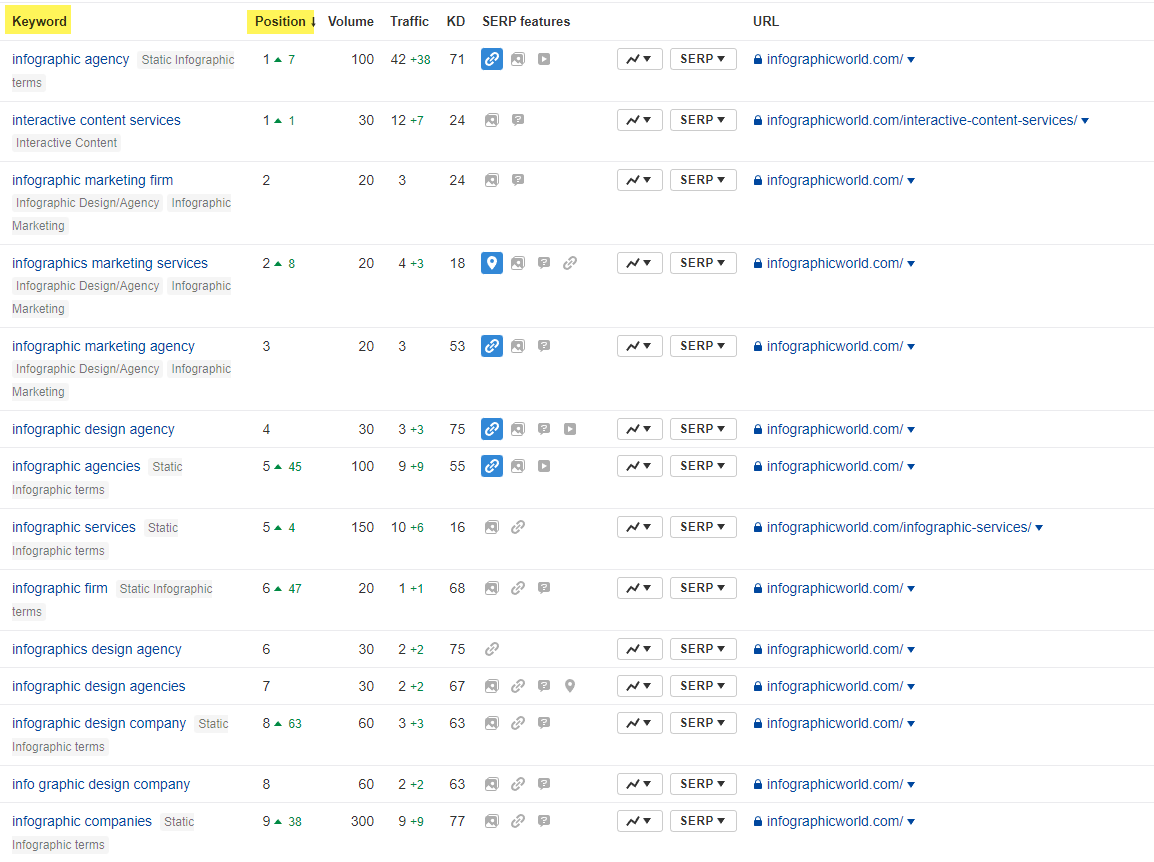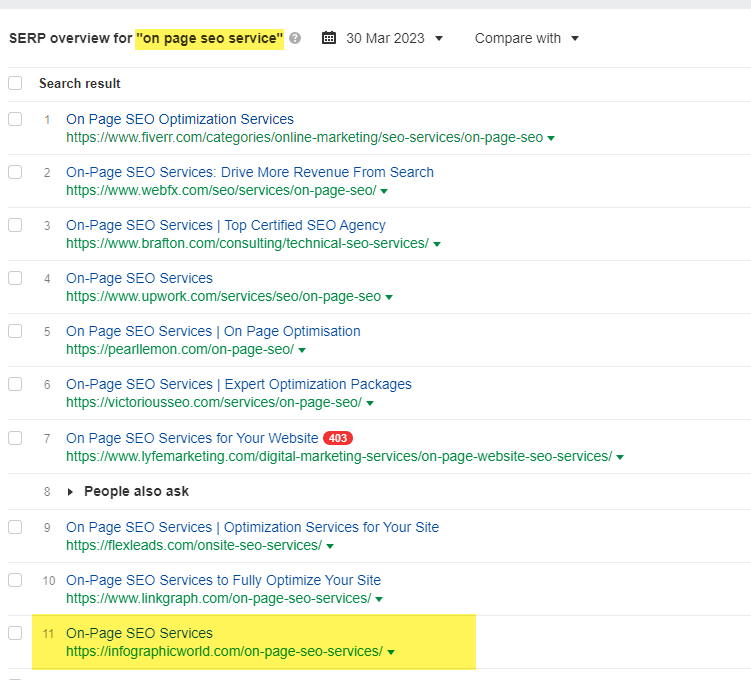When it comes to foundational elements of sound SEO strategy, few things are more important than on page SEO strategy. Often a make or break factor in how your page performs, on page SEO can very often be overlooked, or done lazily. Here to save you from yourselves, we’ve compiled a quick list of 9 tip to make sure you get the full benefit of proper on page SEO efforts:
1. Conduct Thorough Keyword Research
Identify relevant and high-volume keywords for your target audience using tools like Google Keyword Planner, SEMrush, or Ahrefs. Ahrefs is a personal favorite of ours, and it seems to always set me down rabbit hole after rabbit hole discovering more and more amazing high-intent keywords. I use the phrase high-intent very purposely. It’s our philosophy at IGW that the only keywords that matter are high-intent keywords. Either they’re keywords that demonstrate that the searcher is, in that very moment, looking for exactly what it is that you offer, or we’re not interested. This helps us to hone on the highest value targets, and not get caught up in vanity keywords. Perfect example:
- Infographic
- 88,000 searches for the keyword infographic, and I have barely spent a moment in the last 15 years focusing energy and attention to ranking for it. It’s just our philosophy to not chase shiny objects with large search volumes, unless they are actually high-intent. The search term ‘infographic’ is as likely to be searched by someone wondering what the term means, or looking for a free software, or wondering how they’re built, or any of 100 reasons.
- I would MUCH rather be focusing my attention on a keyword like this:
- But that keyword only shows 70 searches a month, why care? Because someone doing a search for infographic agency has made it very clear that they are looking to hire a company that builds infographics. This is the kind of keyword I want IGW ranking top 5 on Google for, which is in fact that case, as we fluctuate between #1 and #3 these days.
- If you look at our rank tracker on Ahrefs, you will see just what I mean in terms of focus:
- But that keyword only shows 70 searches a month, why care? Because someone doing a search for infographic agency has made it very clear that they are looking to hire a company that builds infographics. This is the kind of keyword I want IGW ranking top 5 on Google for, which is in fact that case, as we fluctuate between #1 and #3 these days.

You can see we like to focus on high-intent terms, and being ranked well for these terms means we get a nice steady flow of forms filled out on our website from super high-intent searchers, who come in and are most likely to convert into new customers. Give me that all day over being Top 5-10 ranked for the word ‘infographic.’
2. Optimize Meta Tags
Craft compelling and keyword-optimized title tags and meta descriptions that accurately describe the content of your page and entice users to click.
The key here is to truly consider what this is; this is your chance to grab the attention of the person who is doing the search, and convince them that only YOUR page is worth clicking on, not those other worthless ones above and below you. Sticking with something completely generic and identical to everyone else around you means you’re purely leaving it up to chance. Try to stand out in some way. But for starters, go actually look at what the pages ranking top are using for their meta titles and descriptions. See if there is an angle you can use to look a bit different, but maintaining a professional look so you are viewed as credible by the person doing the search.
Another important thing to remember to do is routinely (ie: bi-weekly or monthly) do a check on Google Search Console to see how your CTRs (click-through-rates) are for these pages based on keywords you care about. This is a crucial piece of data to study intensely, as once you are ranking well for your keywords, this becomes a bit similar to testing headlines and ad copy in Google Ads. If you see that your CTR is underperforming (assuming enough impressions to be a good sample size), this is the moment to test and play around. Try switching up the title and/or description, give it a week, and see how the CTRs look compared to the time before the change. If no change (or worse), change it up again. If improved, you might be on to something. Make testing and improving a definitive part of your process.
3. Use Header Tags Strategically
Break up your content with header tags (H1, H2, H3) to improve readability and signal the hierarchy of information to search engines.
As a general rule, aim to have the page’s most important keyword be in your H1 tag, and only have 1 H1 tag. Your batch of secondary importance keywords can be used within your H2 tags, and next level ones in H3. I like to have a good variety, and I’ll definitely repeat very important keywords.
4. Create SEO-Friendly URLs
Develop short, descriptive URLs that include your target keywords and are easy for users to read and understand. For example, for our on page SEO service page, the slug is literally /on-page-seo-services. We keep things simple and to the point, always including a crucial keyword in the URL itself.
 5. Include Keywords Naturally
5. Include Keywords Naturally
Incorporate your target keywords throughout the content in a natural and relevant manner, avoiding keyword stuffing. Google is going to know you’re just trying to game things if you use the same keyword over and over and over on a page, in a completely unnatural way. Just keep it natural, but at the same time, it’s okay to go out of your way to ensure you use your important keywords a few times.
6. Optimize Images
This is more important than ever since Google’s Core Web Vitals update a few years ago. It’s crucial that you do everything you can to have the quickest site speed experience for users, as it’s become a huge factor for Google.
Compress image file sizes to improve page load speed, and use descriptive file names and alt text to help search engines understand the content of the images.
7. Internal & External Linking
Add internal links to relevant pages on your website and external links to authoritative sources to provide additional value to users and improve your website’s credibility.
Both of these elements, I find, are overlooked. The external linking part is helping Google understand if you are sourcing data and information from highly credible sources, vs just making things up or sourcing from random blogs. This is about as simple of a thing to implement as possible.
INTERNAL LINKING, on the other hand, is by far the most underappreciate and underutilized aspect of SEO strategy. I would go as far as to say it’s one of if not tied for most important things we focus on in our SEO efforts with clients (and ourselves). It is of utmost importance that your website have related content and pages be linking internally to one another. It creates a connective tissue that Google crawls and helps connect dots on what is related to what, and what authority you have on given subjects. It also is a MAJOR tactic we use to improve a specific page’s rankings. Rarely will a week go by where I have not done multiple sweeps of what pages are nearing their target ranking zone, and after identifying which need that extra boost, I will do a search for a handful of blog posts and other pages on the related topic, go in and add contextual internal linking back to the target page, using the most important keywords in the anchor text.
For example, our on page SEO service page is currently ranked #11 on Google for the search term ‘on page seo service.’ See what I did there? In a completely natural way in how I would refer to the page as I can, and using an anchor text of the keyword I’m going after, I just added a bit of internal linking juice to a very important page for us.

SO close to 1st page we can taste it
Just tonight, after seeing our page moved up to the #11 spot, I went into the backend of our WordPress, did a search for our articles on SEO, pulled up 10 of them, and found natural spots where I could add in internal links back to this page, using a tight variation between ‘on page SEO service’ ‘on page SEO services’ and ‘on page SEO strategy.’ My hope is that by next week, we can crack the 1st page of Google for a killer SEO keyword, which if you want to say you are amazing at SEO as a company, you need to bring it, and get yourself 1st page ranked for the same keywords EVERY OTHER SEO agency in the world is trying to rank for. I look forward to working our way to Top 5 in the coming months.
8. Create High-Quality Content
Focus on producing informative, engaging, and shareable content that offers value to your audience and keeps them on your page for longer. A lower quantity of super high quality, long-term content, is better than spewing out hundreds of low quality content posts. That said, there’s nothing wrong with create decent sized batches of content for keyword clusters.
9. Monitor and Adjust
Regularly analyze your on-page SEO performance using tools like Ahrefs, Google Analytics and Google Search Console, and make adjustments as needed to continuously improve your strategy.
I have the unhealthy habit of checking out ours and our clients SEO performance multiple times a day. Which is about as intelligent as watching your stock performance and judging it daily, but I am an SEO nut, and cannot get enough of going through the data, results, studying the competition, and devising ways to beat them.
I hope you found this article helpful in your on page SEO endeavors. If in doubt, you can always reach out to us here for any assistance at all.




 5. Include Keywords Naturally
5. Include Keywords Naturally
